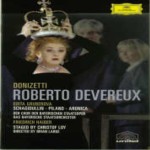This modern-dress production takes place in what I first thought was an airport lounge but later realized was a men’s club, complete with leather chairs, bar, water cooler, and magazine rack. That, indeed, is the metaphor–that Westminster is/was a men’s club in which a woman is/was the ruler. Our Elisabeth is dressed in a business suit, as are all the other men and women on stage, colored in shades of gray and blue–almost anything bland, except for a powder-blue number in the second act for Elisabeth (sets and costumes are by Herbert Murauer; the production is by Christoph Loy). The metaphor may work but the effect is damp. Except for the fact that in the final act Elisabeth wears diamonds and a floor-length black velvet dress and takes a crown out of the glass case also housing her scepter and orb, we have no way of knowing Elisabeth is the queen. She’s not really deferred to, nor are her entrances and exits particularly momentous. Essex does not kowtow to her; indeed he is defiant. Yes, it’s a men’s club and Elisabeth will remain a woman, no matter her rank; but frankly, you find yourself missing the pomp.
This is not to say that the show is unsuccessful. In fact, in the opera’s final moments, when Elisabeth, by now shattered and nearly demented, removes her red wig to reveal a head of sparse, gray hair, we are deeply moved at having seen the moment-by-moment crumbling of this powerful monarch and powerless woman, which is surely what Donizetti desired. And within the production’s framework the performance is stunning.
The role of Elisabeth is Donizetti’s greatest female character and contains his most challenging music, and Edita Gruberova probably has never been better. The coloratura is difficult, as it invariably is with this composer, but the dynamic and vocal range is even more taxing: the soprano is required to sing at great volume throughout the range and it can severely damage a voice (Beverly Sills once claimed that the role took 10 years off her career). At this stage of her career Gruberova’s superb technique has kept the voice intact, and she is fearless, hurling out the text with maximum force. Her weird grimacing always has been a bit hard to take, particularly in close-up, but this is a great performance, no doubt about it.
The rest of the cast is fine. Roberto Aronica sings the title role with passion and ringing tone. After he’s beaten up by Elisabeth’s thugs, he performs his final, pre-execution aria bloodied, blindfolded, and in his underwear and still manages to make it work. Baritone Albert Schagidullin makes a good, conflicted Nottingham, and Jeanne Piland’s Sara is well-sung and almost sympathetic.
My preference for videos of this opera remains Beverly Sills’ despite the fact that it was taped late in her career; I haven’t seen the one starring Alexandrina Pendatchanska. However, this new version is very special indeed, and Gruberova is remarkable. As ever, Brian Large’s direction for the small screen is sensitive and intelligent. Sound is PCM Stereo or DTS 5.0; subtitles are in English, German, French, Spanish, and Chinese. There is a bonus documentary about the making of this production with interviews with the director and Gruberova.
































